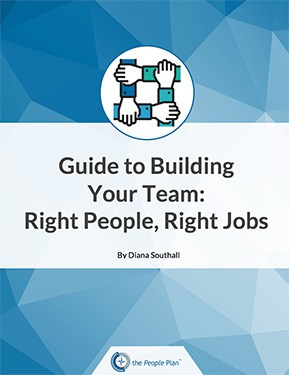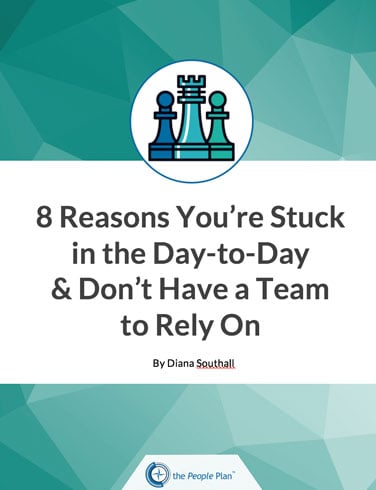
by Diana Southall | Jan 20, 2014 | culture, job fit, performance
As your business grows beyond just a single owner in the role of general manager, you begin to build team of managers and senior professionals.
You find people who are willing to come onboard and help you build the business, and they are committed and loyal and hardworking. They came to work for your company for a paycheck but ultimately they would like to share in the success of the organization. Or perhaps you have a profit sharing/ bonus/ incentive plan that you offer now.
Many organizations design plans with the intention of rewarding key people with more than base pay, and every possible type of plan can emerge as a result.
As Dr. Phil has been known to say “how is that working for you?”
Here are 8 questions to ask about how you are compensating your key employees (count how many you can answer with “yes”):
- Do managers know exactly what they need to do this year to achieve the business goals (do they have a dashboard or scorecard)?
- Do managers know what the reward will be if they hit the results on their scorecard? (For example, if they achieve the goals exactly, what will they earn?)
- Is there a significant individual component to incentive compensation?
- Does the current reward structure emphasize long-term (5+ years) results/ metrics (more than just annual ones)?
- Have you gathered official data in the last 18 months to check if current base pay and annual incentive is “market competitive”?
- What is the perception of your compensation including incentives—is there a meaningful reward for exceptional results? Is it considered “fair”?
- How have you designed a plan that uses the different levers (base pay, short term incentive, long term incentive and benefits) for the highest value to employees, the best alignment with company goals, and the lowest post tax payroll cost?
- Have you built any mechanism to use compensation for future plans- owner retirement and/or ownership transition?
If you answered YES to at least 5 of those questions, I would suggest you have a well designed and possibly effective “pay for performance” program for your key employees.
If you only answered yes to a few or several answers are “sort of” you are not alone— we work with many very successful small companies that have outgrown their rewards programs and are challenged with each of these issues. (Some are $50 to $500 million in revenue!).
The good news that you can leverage the impact of an effective Total Rewards program, and this will align compensation with business results and be designed for future growth.
Email us to find out about our systematic 5 phase design process that customizes a solution for your unique needs, and can be ready in about 6 months.
Image courtesy of FreeDigitalPhotos.net

by Diana Southall | Jan 3, 2014 | rewards
The beginning of a new year and also that time of year when employee thoughts turn to… (well on the East Coast everyone is thinking wistfully of spring) “When am I going to get a pay increase?”
Thanks to 50 years of prosperity and a small dose of influence from union contracts, the American worker has been conditioned into thinking (expecting) that they will get a regularly schedule raise in pay in January. The legacy of 20 years of consistent pay practices lives on.
I don’t need to rehash the economic news of the last 6 years, but pay increases since 2008 have been well below the former 3% standard set by the prosperous years, and wage freezes and 18-24 spans between increases are fairly common.
If you are smaller employer or one who has limited profits to continually raise your payroll budget 3% every year, how will you possibly attract great people and retain your top performers?
The good news is that you actually have 12 non-financial ways to reward your employees. Here is a list with some possible solutions.
1. Voluntary (employee paid) benefits—many employers now offer the option for employees to purchase additional benefits at their own cost. The employee typically receives a lower cost for the coverage and it may have tax advantages.
Solution- insurance plans- dental insurance, long term disability or life insurance
2. Work itself– the number one factor in job satisfaction is a sense of achievement. Ask employees how you can improve their work with more variety, sense of purpose or meaning, and challenging assignments
Solution- give your high potential employee a project to manage
3. Autonomy— show of hands- who likes to be micromanaged? Anyone? If you train someone and give appropriate guidelines you can trust the work will be done as needed.
Solution: consider the last 5 questions that someone “ran by you” – is there nugget of wisdom you can share so that you do not have to be consulted or are you just being the chief problem solver?
4. Work load— are you overloading your best performer because she will always take on more and get it done? Does this sound like a recipe for burnout?
Solution: ask your busiest person what you can take off their plate, and then create a plan to do this immediately
5. Resources one of the top reasons people leave their job is because they do not have the tools to do the job properly
Solution: have a meeting to list out hassles and pick the biggest time waster to that inexpensive resources or tools will improve
6. Reliable coworkers– If you have ever worked with someone is who not pulling their weight, then you know how this can make you hopping mad. People have one of three responses: work harder and put up with the slacker, work less so that you don’t feel taken advantage of, or look for another job. If you allow lower contributions you are actually driving out the good performers. And then you are left with the lowest ones.
Solution: If you know who is your weakest link do not wait to have a crucial conversation (see feedback below). Sometimes you have a sense someone is not doing their best but others cover for that person so you don’t know the full extent of the gap. Also allow confidential opportunities to get this feedback from your team.
7. Performance discussions- Yes everyone hates the “performance review,” but on the flip side employees want the opportunity to talk about their role, aspirations and to be appreciated for all their hard work.
Solution: change up your process- stop focusing so much on putting a numerical rating on last year, and more about how the last year provided insights for how to reach goals for this year. I when I say goals I mean how the employee can reach his/her goals within the job.
8. Feedback- Employees expect you to tell them right away if they are not meeting expectations. And they should expect that you deliver this feedback in a positive and constructive manner.
Solution: If you are not comfortable delivering constructive feedback then I suggest reading a few books (101 Tough Conversations is a good start) and then starting small. Trust me, your other employees will thank you for finally have those crucial conversations.
9. Recognition- Timely and targeted public praise is only the cheapest and most powerful reward tool a manager has. If you don’t know what to recognize then you need to sit down and make a list of what behaviors will reach your organization’s goals this year.
Solution: Be on the lookout for a person that did something terrific that is on your list of things to recognize, and publicly praise in your weekly team meeting (you have one, right?)
10. Training and development– Most people want to feel that we are “good” at our job and will be frustrated or demoralized if something is too difficult. A lack of challenging work is also a main reason people look for another job, so you may want to continually upgrade the knowledge and skills so that people don’t get bored. It’s a win-win- employees feel valued and broaden their knowledge and capability, and now you have an employee who can contribute and perform more.
Solution: employees may not be open about their so you want to ask find out what training would dramatically improve performance or if they want a new challenge.
11. Opportunity for Advancement– Surveys show that about half of employees feel there is not a chance for promotion at their employer. For the generation Y who will comprise almost half the workers in the US, a clear career path and opportunities to advance is the top reason for job engagement.
Solutions: If you want people to be loyal, committed and willing to go above and beyond (aka engaged), identify and share the “next” job (not necessarily in management), the change in duties and responsibility, and a training plan to develop into that role.
12. A great boss (I mean coach)- as the saying goes, people leave supervisors, not companies. If you feel unappreciated, criticized, or just plain frustrated by your direct manager you will consider looking for a new one. Coaches are clear about the goals, deliver feedback and train in a positive supportive and appreciative way, and focus on improvement.
Solution: There are so many books and training on how to be a coach and not a boss, but it might help to ask some of the employees you trust where you should work first. We all have blind spots and perhaps a few key changes will dramatically change how you are perceived and the impact you make.
Want to learn more about how to use Total Rewards to attract, engage and retain your best teammates?
Image courtesy of FreeDigitalPhotos.net

by thepeopleplan | Dec 20, 2013 | Uncategorized
More than half of for-profit employers pay out some sort of “year-end bonus” – sometimes it’s called incentive, profit-sharing, distribution, bonus checks.
I heard two examples this month of employees who were actually disappointed/ mad after receiving a fairly generous bonus!
Many well-meaning employers have one of these “plans” but there are two key problems that indicate you should re-design the plan:
1 vytorin 10 40. Not linked to performance
For most small employers and a surprising number of large ones, it is also a mystery to employees how they “earned” it and how they can get a bigger one next year. Your employee is thinking something along the lines of “thanks for the $500, what is it for?”
If you are going to spend money – cold hard-earned profits- I suspect you want to get some “bang for your buck.”
If your employees do not understand these three things, it’s time for a re-design:
- why they received $x in annual incentive,
- how it ties to either their and/or the company performance, and
- what they can specifically do next year to make this incentive larger
2. Becomes an “entitlement”
I have yet to meet an employee who will turn this down but often employees are actually MAD or disappointed when they get their bonus check.
Can you believe it!? An owner or manager group could take all the profits for themselves, yet they choose to share some with the staff. Instead of feelings of gratitude and joy, a poorly designed or communicated plan actually has the opposite effect.
And these feelings can linger and fester and actually lower the commitment and enthusiasm of your staff.
Yikes! A client recently used the phrase that sums this up: “we don’t need to spend money to piss people off!”
Typically the reason employees are actually dissatisfied with the bonus amount is because they expected more (for whatever reason) or think their amount is “unfair.”
Perhaps they thought they would get the same as last year (entitlement thinking) but profits were down so the overall pool was less. Or they thought that the promotion to manager would earn a bigger bonus. Or I should earn more than Larry because (fill in reason here.)
If you are hearing grumblings or outright complaints, it’s time for a re-design. Sometimes the plan is effective but it needs to be better communicated to shape employee expectations, explain the equity in method, and align performance with the payout.
The solution to bonus pains: Our model is to leverage the three 3C’s necessary to have a successful performance-based incentive plan- under employee’s Control, not Complex, clearly Communicated for alignment to company goals.
We have a ten step process to make sure your plan shows what is important to achieve, how each person contributes, and how they can be rewarded.
If you are interested in getting more bang for your incentive buck next year, I’m happy to chat- click here to book a phone session
Image courtesy of Stuart Miles at FreeDigitalPhotos.net

by thepeopleplan | Jun 11, 2013 | culture
Top ten global engagement drivers
You have at least met (if not work with) someone who is NOT engaged– they show up and barely do the job.
What can be a delight for co-workers and managers is someone who is “actively engaged.” Engagement is when an employee expends discretionary extra effort in their job— studies show that about 20% of US workers fit this category but some organizations have more than 40% engaged workers.
What influences an employee to go “Above and beyond?”
I have grouped them into four categories and will discuss suggestions for improving these (see number 1 below) with future articles.
1. How the organization treats people
- Senior management sincerely interested in employee well-being
- Organization’s reputation for social responsibility
- Organization quickly resolves customer concerns
2. What is valued at the organization?
- Set high personal standards
- Organization encourages innovative thinking
3. Employee role/ relationship
- Good relationship with supervisor
- Employees feel they have input into decision-making in their department
4. Development and career opportunities
- Enjoy challenging work assignments that broaden skills
- Improved my skills and capabilities over the last year
- Have excellent career advancement opportunities
(Source : Towers Watson study of the global workforce, Closing the Engagement Gap)
Many managers may be surprised that social responsibility and how customers are treated impacts employee performance. But employees are always considering not just how they are treated, but also how others are treated, and want to take pride in their employer and the organization’s decisions and direction. (For example, I have a colleague who begrudgingly took a job at a local company that is under investigation by the DEC for polluting the neighborhood, and she is not exactly “proud” to promote her new position.)
Three steps you can take NOW to improve employee perceptions of how people are treated:
- Spend 10 minutes once a week going around to exchange “small talk” with employees, finding out more about their lives outside the office and what is important to them (bonus points if you know names of kids, grandkids, and pets as well as favorite hobbies)
- Ask your key team members to suggest one way the organization can improve social or environmental responsibility, and then implement this idea
- Decide one way customers requests can be fulfilled more quickly or conveniently.
Thanks to Terry Williams of the Brain Based Boss for alerting me to this interesting research.

by thepeopleplan | Apr 16, 2013 | culture, job fit, performance
In a study by the Labor Relations Institute of NY, managers selected what they thought employees valued most, and then asked employees what they valued:
Manager /Employee rank- Job Reward
- 1/ 5- Good wages
- 2/ 4- Job security
- 3/ 8- Promotion and growth
- 4/ 9- Good working conditions
- 5/ 6- Interesting work
- 6/ 7- Personal loyalty to workers
- 7/10- Tactful discipline
- 8/ 1- Appreciation for work done
- 9/ 3- Sympathetic help with personal problems
- 10/2- Feeling “in” on things
You can see that the TOP 3 for employees were listed as the BOTTOM 3 in the eyes of managers. Hmm.. I wonder how much time and effort these managers put into these “bottom” rewards if they consider such each a low priority?
As a specialist in compensation, we regularly visit prospective clients who are convinced that their organization needs to pay more to attract, retain and motivate their team members. (And some of them do indeed have issues with pay below the market or internally inequitable.)
However, if your pay is fair for the work you expect and compared to others in your organization, one of the best investments you can make in building a terrific team is with recognition.
Recognition is practically free and creates an immediate impact such as:
- reinforcing company values
- aligning employee efforts to achieve organizational results
- appreciating specific employee efforts (then they continue to do these)
- modeling what ABC- attitudes, behaviors and contributions are valued (others start doing these)
- creating a positive work environment and culture (as more employees demonstrate the desired ABC’s and are recognized for them)
(Manager Survey Source: Foreman Facts, Labor Relations Institute of NY, 2004)
For a Quick recognition template view our 4/23 blog post
Image courtesy of watcharakun at FreeDigitalPhotos.net








